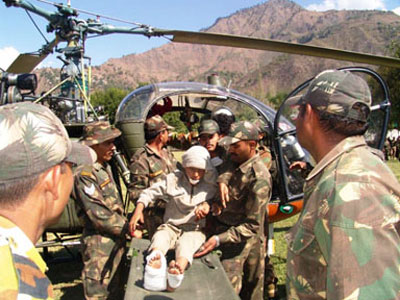By Gp Capt Tarun Kumar Singha VSM | PUBLISHED: 17, Jan 2014, 17:41 pm IST | UPDATED: 18, Jan 2014, 13:45 pm IST

In the Burma campaign of 1942, a brave young Indian captain lay by the Sittang River wounded in the stomach by a burst of Japanese light machine gun fire. Fearing for worst, British Major General D.T. Cowan pinned his own Military Cross ribbon on the valiant officer as it was never ever awarded to any dead person.
The young officer eventually survived his near-death ordeal, thanks mainly to the army doctors. Years later as the army chief he went on to lead the Indian armed forces to one of its greatest military victory ever that saw the emergence of a new nation, Bangladesh.
It is indeed the story of late Field Marshal Sam Hormusji Framji Jamshedji Manekshaw, remembered ever so popularly as 'Sam Bahadur'. Had it not been for an ironical twist of fate, it could have been Manekshaw himself playing the role of a saviour doctor, something he cherished to be in the footsteps of his former military-doctor father.
That one of his younger siblings, Air Vice Marshal Jemi H.F.J. Manekshaw served as a doctor in the military would give Sam Bahadur a lot of satisfaction, reveals Major General B.N.B.M. Prasad, presently Commandant, Command Hospital, Kolkata, who was the personal physician to the late Field Marshal in his final years.
The story only reinforces the truth that while universally soldiers are deemed men of steel, they are only as mortal as all of us. They also fall ill, get wounded in battles and succumb to injuries. Only a fit soldier - be it on land, air or sea -can effectively live to fight another day.
For ensuring soldiers soldier on, a fraternity of doctors, surgeons and nursing staff comprising the behemoth Army Medical Corps (AMC) that commemorated its 250th Raising Day on January 1, 2014, words fall short in their praise for having been around for nearly quarter of a millennium and still counting.
The genesis of medical services in India was laid on the first day of the Gregorian calendar in 1764 when the Bengal Medical Service got first raised after the East India Company began employing military surgeons from 1745 onwards for its troops.
The Madras and Bombay Medical Service followed suit in 1767 and 1779. Together they were responsible for the three Presidency Armies of Bengal, Madras and Bombay, respectively.
In March 1896, the medical services of all the three Presidencies of the Company were integrated to form one Indian Medical Service (IMS) primarily responsible for medical care of the Indian Army.
Incidentally, among the several historical monuments from the 18th century existing in and around Kolkata, stands a landmark building that was conceived and planned as a military general hospital by Lord Clive for Fort William in 1757.
The monumental two-storeyed building located at 246 Acharya Jagdish Chandra Bose Road, Alipore, whose existence is recorded from as early as 1787 would eventually be turned into a 60-bedded military hospital in 1870.
It remained here for nearly a century till it relocated to nearby Alipore in 1970, in its present day avatar as the Eastern Command Hospital. Ironically, the foundation for the hospital was laid by late Field Marshal Manekshaw during his stint earlier as Eastern Army Commander. The old heritage building is now the Headquarters of Army's Bengal Area.
Until WWI, the Indian Medical Service was pre-dominantly civil in character. The outbreak of WWII in 1939 led to the formation of Indian Army Medical Corps (IAMC) on April 3, 1943.
The IAMC was finally re-designated as Army Medical Corps (AMC) with effect from January 26, 1950. The first paratrooper medical team was also organised in the same year as was the foundation for the Armed Forces Medical College in Pune.
The post of Director General (DG), Armed Forces Medical Services (AFMS) was created earlier in 1949 as coordinating head of the medical services of the Army, Navy Air Force, Military Nursing Service and Army Dental Corps with DG of the respective medical services functional under DG AFMS.
With a countrywide network of 127 hospitals and 87 field medical units, the AFMS provides comprehensive medical care spanning the entire spectrum of preventive, curative and rehabilitative services to the serviceman, ex-servicemen and their families.
The AFMS have always excelled in their role whether in combat medical support or providing the most advanced and specialised treatment at state of the art medical facilities.
They have always been among the first responders in situations like disasters and natural calamities within the country or abroad. The medical services provided by Indian UN Missions and other relief teams have generated tremendous goodwill among the international community.
The IMS also laid the foundation of secular-scientific medicine, public health services and research in the country. Most of their contributions in the field of medical research were outstanding and were of great benefit to India and rest of the world.
In its semi-quincentennial year, notable names to be recalled include a British military doctor born in India, Sir Ronald Ross who was awarded the Nobel Prize for medicine in 1902 for his work in malaria, which affected soldiers and others alike devastatingly.
Assistant Surgeon, S.C.G. Chuckerbutty was the first Indian to enter the medical service on January 24, 1855. The first lady doctor was commissioned in IMS, in April 1942.
The healing touch of the army doctors, nurses and paramedics have saved countless lives of soldiers and their families from battlefields and beyond. Donning an angelic demeanour in their everyday lives they have also been as valiant as any heroic soldier.
Major Laishram Jatin Singh, an army doctor was posthumously awarded the Ashok Chakra for his exemplary courage and valour in the face of a terrorist attack on the Indian Embassy, Kabul in 2010, sacrificing his life saving 10 colleagues.

by : Priti Prakash
When Russian President Vladimir Putin landed in New Delhi for the 23rd India–Russia Annual Summit ...